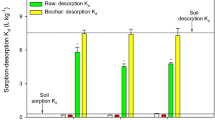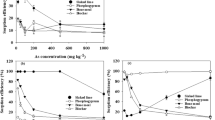Abstract
Purpose
Diethyl phthalate (DEP) is one of the most commonly used plasticizers as well as a soil contaminant. Using biochar to remediate soils contaminated with DEP can potentially reduce the bioavailability of DEP and improve soil properties. Therefore, a laboratory study was conducted to evaluate the effect of biochar on soil adsorption and desorption of DEP.
Materials and methods
Two surface soils (0–20 cm) with contrasting organic carbon (OC) contents were collected from a vegetable garden. Biochars were derived from bamboo (BB) and rice straw (SB) that were pyrolyzed at 350 and 650 °C. Biochars were added to two types of soil at rates of 0.1 and 0.5 % (w/w). A batch equilibration method was used to measure DEP adsorption-desorption in biochar treated and untreated soils at 25 °C. The adsorption and desorption isotherms of DEP in the soils with or without biochar were evaluated using the Freundlich model.
Results and discussion
The biochar treatments significantly enhanced the soil adsorption of DEP. Compared to the untreated low organic matter soil, the soils treated with 0.5 % 650BB increased the adsorption by more than 19,000 times. For the straw biochar treated soils, the increase of DEP adsorption followed the order 350SB > 650SB. However, for the bamboo biochars, the order was 650BB > 350BB. Bamboo biochars were more effective than the straw biochars in improving soils’ adsorption capacity and reducing the desorption ability of DEP.
Conclusions
Adding biochar to soil can significantly enhance soil’s adsorption capacity on DEP. The 650BB amended soil showed the highest adsorption capacity for DEP. The native soil OC contents had significant effects on the soils’ sorption capacity treated with 650BB, whereas they had negligible effects on the other biochar treatments. The sorption capacity was affected by many factors such as the feedstock materials and pyrolysis temperature of biochars, the pH value of biochar, and the soil organic carbon levels.





Similar content being viewed by others
References
Adhoum N, Monser L (2004) Removal of phthalate on modified activated carbon: application to the treatment of industrial wastewater. Sep Purif Technol 38:233–239
Ahmad M, Rajapaksha AU, Lim JE, Zhang M, Bolan N, Mohan D, Meththika V, Lee SS, Ok YS (2014) Biochar as a sorbent for contaminant management in soil and water: a review. Chemosphere 99:19–33
Api A (2001) Toxicological profile of diethyl phthalate: a vehicle for fragrance and cosmetic ingredients. Food Chem Toxicol 39:97–108
Bauer M, Herrmann R (1997) Estimation of the environmental contamination by phthalic acid esters leaching from household wastes. Sci Total Environ 208:49–57
Binod P, Sindhu R, Singhania RR, Vikram S, Devi L, Nagalakshmi S, Kurien N, Sukumaran RK, Pandey A (2010) Bioethanol production from rice straw: an overview. Bioresour Technol 101:4767–4774
Bornemann LC, Kookana RS, Welp G (2007) Differential sorption behaviour of aromatic hydrocarbons on charcoals prepared at different temperatures from grass and wood. Chemosphere 67:1033–1042
Brunauer S, Emmett PH, Teller E (1938) Adsorption of gases in multimolecular layers. J Am Chem Soc 60:309–319
Cesarino I, Araújo P, Domingues Júnior AP, Mazzafera P (2012) An overview of lignin metabolism and its effect on biomass recalcitrance. Braz J Bot 35:303–311
Chen B, Chen Z (2009) Sorption of naphthalene and 1-naphthol by biochars of orange peels with different pyrolytic temperatures. Chemosphere 76:127–133
Chen B, Yuan M, Qian L (2012) Enhanced bioremediation of PAH-contaminated soil by immobilized bacteria with plant residue and biochar as carriers. J Soils Sediments 12:1350–1359
Deshpande AP, Bhaskar Rao M, Lakshmana Rao C (2000) Extraction of bamboo fibers and their use as reinforcement in polymeric composites. J Appl Polym Sci 76:83–92
Dong D, Yang M, Wang C, Wang H, Li Y, Luo J, Wu W (2013) Responses of methane emissions and rice yield to applications of biochar and straw in a paddy field. J Soils Sediments 13:1450–1460
Haghseresht F, Lu G, Whittaker A (1999) Carbon structure and porosity of carbonaceous adsorbents in relation to their adsorption properties. Carbon 37:1491–1497
Koelmans AA, Jonker MT, Cornelissen G, Bucheli TD, Van Noort P, Gustafsson Ö (2006) Black carbon: the reverse of its dark side. Chemosphere 63:365–377
Larry H, Welliam A (1979) Priority pollutants. Environ Sci Technol 13:416
Liu Y, Liu Y, Wang X (2007) Study on adsorbent choice used in oil bleaching process. Food Sci 28:25–39
Liu Y, Yang M, Wu Y, Wang H, Chen Y, Wu W (2011) Reducing CH4 and CO2 emissions from waterlogged paddy soil with biochar. J Soils Sediments 11:930–939
Lu Y, Tang F, Wang Y, Zhao J, Zeng X, Luo Q, Wang L (2009) Biodegradation of dimethyl phthalate, diethyl phthalate and di-n-butyl phthalate by Rhodococcus sp. L4 isolated from activated sludge. J Hazard Mater 168:938–943
Luo J, Ma M, Liu C, Zha J, Wang Z (2009) Impacts of particulate organic carbon and dissolved organic carbon on removal of polycyclic aromatic hydrocarbons, organochlorine pesticides, and nonylphenols in a wetland. J Soils Sediments 9:180–187
Mackintosh CE, Maldonado JA, Ikonomou MG, Gobas FA (2006) Sorption of phthalate esters and PCBs in a marine ecosystem. Environ Sci Technol 40:3481–3488
Pignatello JJ (2013) Role of natural organic matter as sorption suppressant in soil, functions of natural organic matter in changing environment. Springer, pp 501-504
Qiu Y, Zheng Z, Zhou Z, Sheng GD (2009) Effectiveness and mechanisms of dye adsorption on a straw-based biochar. Bioresour Technol 100:5348–5351
Rayment GE, Higginson FR (1992) Australian laboratory handbook of soil and water chemical methods. Inkata Press, Melbourne, Australia, 330 pp
Sarmah AK, Srinivasan P, Smernik RJ, Manley-Harris M, Antal MJ, Downie A, Van Zwieten L (2010) Retention capacity of biochar-amended New Zealand dairy farm soil for an estrogenic steroid hormone and its primary metabolite. Soil Res 48:648–658
Schaffer M, Boxberger N, Börnick H, Licha T, Worch E (2012) Sorption influenced transport of ionizable pharmaceuticals onto a natural sandy aquifer sediment at different pH. Chemosphere 87:513–520
Shailaja S, Ramakrishna M, Venkata Mohan S, Sarma P (2007) Biodegradation of di-n-butyl phthalate (DnBP) in bioaugmented bioslurry phase reactor. Bioresour Technol 98:1561–1566
Song Y, Wang F, Yang X, Bian Y, Gu C, Xie Z, Jiang X (2012) Influence and assessment of biochar on the bioavailability of chlorobenzenes in soil. Huan Jing Ke Xue 33:169–174
Stales CA, Peterson DR, Parkerton TF, Adams WJ (1997) The environmental fate of phthalate esters: a literature review. Chemosphere 35:667–749
Sun K, Jin J, Keiluweit M, Kleber M, Wang Z, Pan Z, Xing B (2012) Polar and aliphatic domains regulate sorption of phthalic acid esters (PAEs) to biochars. Bioresour Technol 118:120–127
Wang H, Lin K, Hou Z, Richardson B, Gan J (2010) Sorption of the herbicide terbuthylazine in two New Zealand forest soils amended with biosolids and biochars. J Soils Sediments 10:283–289
Wang J, Luo Y, Teng Y, Ma W, Christie P, Li Z (2013) Soil contamination by phthalate esters in Chinese intensive vegetable production systems with different modes of use of plastic film. Environ Pollut 180:265–273
Yang G, Zhao X, Sun X, Lu X (2005) Oxidative degradation of diethyl phthalate by photochemically-enhanced Fenton reaction. J Hazard Mater 126:112–118
Yang X, Ying G, Peng P, Wang L, Zhao J, Zhang L, Yuan P, He H (2010) Influence of biochars on plant uptake and dissipation of two pesticides in an agricultural soil. J Agr Food Chem 58(13):7915–7921
Yao H, Lu J, Wu J, Lu Z, Wilson PC, Shen Y (2013) Adsorption of fluoroquinolone antibiotics by wastewater sludge biochar: role of the sludge source. Water Air Soil Pollut 224:1–9
Zeng F, Cui K, Li X, Fu J, Sheng G (2004) Biodegradation kinetics of phthalate esters by Pseudomonas fluoresences FS1. Process Biochem 39:1125–1129
Zhang H, Lin K, Wang H, Gan J (2010) Effect of Pinus radiata derived biochars on soil sorption and desorption of phenanthrene. Environ Pollut 158:2821–2825
Zhang X, Wang H, He L, Lu K, Sarmah A, Li J, Bolan NS, Pei J, Huang H (2013) Using biochar for remediation of soils contaminated with heavy metals and organic pollutants. Environ Sci Pollut Res 20:8472–8483
Zheng W, Guo M, Chow T, Bennett DN, Rajagopalan N (2010) Sorption properties of greenwaste biochar for two triazine pesticides. J Hazard Mater 181:121–126
Zheng H, Wang Z, Zhao J, Herbert S, Xing B (2013) Sorption of antibiotic sulfamethoxazole varies with biochars produced at different temperatures. Environ Pollut 181:60–67
Acknowledgments
This work was financially supported by the National Natural Science Foundation of China (41271337), Research Funds of the Department of Education of Zhejiang Province (Y201225755), and Zhejiang A & F University Research and Development Fund (2010FR097, 2012FR063).
Author information
Authors and Affiliations
Corresponding authors
Additional information
Responsible editor: Gabriele E. Schaumann
Xiaokai Zhang and Lizhi He contributed to the work equally and should be considered co-first authors.
Rights and permissions
About this article
Cite this article
Zhang, X., He, L., Sarmah, A.K. et al. Retention and release of diethyl phthalate in biochar-amended vegetable garden soils. J Soils Sediments 14, 1790–1799 (2014). https://doi.org/10.1007/s11368-014-0929-x
Received:
Accepted:
Published:
Issue Date:
DOI: https://doi.org/10.1007/s11368-014-0929-x




